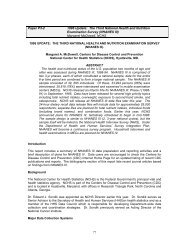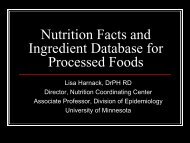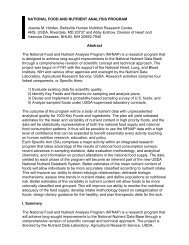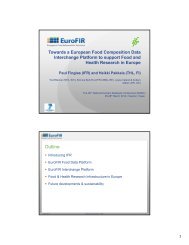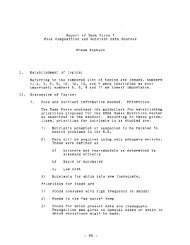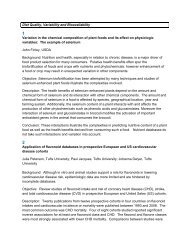Dietary Fiber Database Development for National Health and ...
Dietary Fiber Database Development for National Health and ...
Dietary Fiber Database Development for National Health and ...
You also want an ePaper? Increase the reach of your titles
YUMPU automatically turns print PDFs into web optimized ePapers that Google loves.
<strong>Dietary</strong> <strong>Fiber</strong> <strong>Database</strong><br />
<strong>Development</strong> <strong>for</strong> <strong>National</strong> <strong>Health</strong><br />
<strong>and</strong> Nutrition Survey in Korea<br />
Yoonna Lee, Hae-Jung Lee, Haeng-Shin Lee,<br />
Young-Ai Jang, Cho-il Kim.<br />
Nutrition Research Team<br />
Korea <strong>Health</strong> Industry <strong>Development</strong> Institute, Seoul, Korea
OBJECTIVES<br />
As people get more health-conscious, the<br />
necessity of developing Korean food databases<br />
<strong>for</strong> nutrient contents has become more evident.<br />
To provide correct in<strong>for</strong>mation on diet <strong>and</strong><br />
nutrient intake of consumers, a 5-year project<br />
<strong>for</strong> nutrient database development was started<br />
in 2001.
OBJECTIVES<br />
During last 3 decades, the incidence/prevalence<br />
of chronic degenerative diseases including<br />
coronary heart disease <strong>and</strong> diabetes mellitus<br />
showed a steady increase <strong>and</strong> cancer became the<br />
No. 1 cause of death in Korea.<br />
To provide useful in<strong>for</strong>mation about diet <strong>for</strong><br />
consumers’ health <strong>and</strong> to promote the objectives<br />
of the <strong>Health</strong> Plan 2010, a dietary fiber (DF)<br />
database was developed.
Materials <strong>and</strong> Methods<br />
- Food list -<br />
<br />
<br />
150 Foods were selected <strong>for</strong> total dietary fiber analysis based<br />
on...<br />
2001 <strong>National</strong> <strong>Health</strong> <strong>and</strong> Nutrition Survey data<br />
Foods consumed in large amounts<br />
Foods consumed most frequently<br />
Foods consumed in large amounts by specific age groups<br />
Major source of crude fiber in the Food Composition Table<br />
USDA <strong>National</strong> Nutrient <strong>Database</strong> (SR-18)<br />
High dietary fiber foods were considered<br />
Excluding...<br />
Foods known to lack dietary fiber based on the earlier reports<br />
Among the above, 50 Foods were selected <strong>for</strong> separate analysis<br />
of soluble/insoluble dietary fiber
2001 <strong>National</strong> <strong>Health</strong> <strong>and</strong> Nutrition Survey<br />
102 Foods consumed in large amounts<br />
(covered 95% of total food consumption by weight)<br />
Another 15 foods by consumption frequency<br />
Major source of<br />
crude fiber<br />
27 foods<br />
3 foods<br />
3 foods<br />
Considering<br />
Age difference<br />
USDA: food with high<br />
dietary fiber<br />
150 foods were selected <strong>for</strong> analysis
Materials <strong>and</strong> Methods<br />
Food samples <strong>for</strong> analysis were purchased <strong>for</strong><br />
3 different major br<strong>and</strong>s <strong>and</strong>/or places of<br />
production.<br />
High fat foods (>10%) were defatted be<strong>for</strong>e<br />
analysis using ether (25ml ether/g sample).<br />
Food samples were analyzed <strong>for</strong> dietary fiber<br />
by AOAC991.43 using MES-TRIS buffer.<br />
Enzymatic digestion<br />
(α-amylase, protease,<br />
amyloglucosidase)<br />
Filtration Protein analysis Ash analysis
RESULTS<br />
A <strong>Dietary</strong> fiber database <strong>for</strong> selected Korean<br />
foods was developed, published in printed<br />
<strong>for</strong>m <strong>and</strong> disseminated to universities <strong>and</strong><br />
researchers.<br />
Data file was submitted to RRDI <strong>for</strong><br />
incorporation to the 7th revision of Food<br />
Composition Table, 2006.<br />
With this database, dietary fiber intake of<br />
Korean population was estimated <strong>and</strong><br />
intake profile was analyzed.
Food List<br />
Food<br />
Group<br />
Grains/<br />
Cereals/<br />
products<br />
(33 items)<br />
Potatoes/<br />
Starches (4)<br />
Foods <strong>for</strong> analysis<br />
rice, glutinous rice, brown rice, barley, mixed grains,<br />
sorghum, millet, corn, ramyon, noodles, buckwheat<br />
noodle, rice cake(plain), rice cake w/small red beans<br />
(Si-Ru Tteok), rice cake w/soybean powder (In Jeol<br />
Mi), flour, loaf bread, loaf bread (corn), bread w/small<br />
read bean paste, bread (streusel buns), soft roll, pound<br />
cake, cake, sponge cake, loaf bread powder, chips,<br />
chips(corn), chips(potato), choco-pie, ready to eat<br />
cereal(corn frosted, almond flake), Biscuit, cracker,<br />
ring doughnut<br />
potato, sweet potato, starch vermicelli, acorn starch<br />
jelly
Food List<br />
Food<br />
Group<br />
Foods <strong>for</strong> analysis<br />
Sweets<br />
(1 item)<br />
Pulses<br />
(7 items)<br />
Nuts & Seeds<br />
(4 items)<br />
Mushrooms<br />
(4 items)<br />
Seaweeds<br />
(4 items)<br />
Meat/fish/dairy<br />
products (5)<br />
chocolate<br />
kidney beans, peas, mung beans, small red beans,<br />
soybeans, tofu, soymilk<br />
Perilla seed, sesame seed, peanut, chestnut<br />
4 kinds of mushrooms<br />
Dried Laver, dried sea tangle, dried sea mustard,<br />
sea lettuce<br />
sausage, ham, spam, fish paste, yogurt
Food List<br />
Food<br />
Group<br />
Vegetables<br />
(51)<br />
Foods <strong>for</strong> analysis<br />
eggplant, sweet potato stalks, bracken, green pepper, red<br />
pepper leaves, chard, kimchi (mustard leaves), Kkak Du Ki<br />
(Seasoned cubed radish roots), Kimchi (Na-bak), kimchi<br />
(Dong chi mi), kimchi, kimchi (w/o red pepper), kimchi<br />
(leafy radish), kimchi (cucumber), kimchi (small radish) ,<br />
kimchi (welsh onion), perilla leaves, Shepard’s pulse<br />
(Naeng-yi), carrot, deo-deok, roots of bellflowers, garlic,<br />
garlic, young stem of garlic, radish leaves, radish root, water<br />
dropwort, Korean(Chinese) cabbage, Chinese chive,<br />
broccoli, lettuce, ginger, celery, mung bean sprout, spinach,<br />
mugwort, crown daisy, cabbage, mallow, onion, lotus loot,<br />
cucumber, burdock, Chwi Na Mul (Wild plant, Aster scaber),<br />
soybean sprout, taro stalks, tomato, tomato juice, welsh<br />
onion, sweet green pepper, pumpkin, zucchini
Food List<br />
Food group<br />
Fruits<br />
(17 items)<br />
Beverage<br />
(10 items)<br />
Seasoning<br />
(7 items)<br />
Others (3)<br />
Foods <strong>for</strong> analysis<br />
Persimmon, tangerine, jujube(dried), strawberry,<br />
melon, banana, pear, peach, apple, watermelon,<br />
orange, orange juice, plum, Chinese melon, grapes,<br />
raisin, grape juice<br />
Carrot juice, functional food: dietary fiber drink,<br />
Sik-Hye (sweet rice drink), Tak-Ju (Korean rice<br />
liquor), green tea (canned), citron tea, job’s tears tea,<br />
instant coffee mix, coffee (canned), tea (canned)<br />
Red pepper powder, red pepper paste, soybean<br />
paste, mixed soybean paste w/red pepper paste, black<br />
sauce paste (Ja Jang sauce), curry powder, tomato<br />
ketchup<br />
Wontons, pizza, hamburger
Foods with high content of total<br />
dietary fiber (per 100g edible portion)<br />
g/100g<br />
50<br />
45<br />
40<br />
35<br />
30<br />
25<br />
20<br />
15<br />
10<br />
5<br />
0<br />
b arl y<br />
so rgh u m<br />
m i xe d g rai n s<br />
K id n e y b ea n s<br />
s m al l re d b ean<br />
soyb ea n<br />
m u n g b e an s<br />
g ree n p eas<br />
p eri l la see d<br />
se sa m e s eed<br />
S e a m u s tard (dri ed )<br />
Lav er( d rie d )<br />
S e a ta n g le (d ri ed )<br />
m u g wo rt<br />
p eri l la le ave s<br />
g arl i c<br />
C h wi Na Mu l (Aste r sca b er)<br />
sh e p ard ’ s p u l se (Naen g-y i) ,<br />
yo u n g g a rli c s tem<br />
b rac k en (co o k e d )<br />
d eo -d e o k<br />
ju ju b e(dri ed )<br />
R ed p e p p er p as te<br />
cu rry p o wd er<br />
jo b ’ s t ears tea (p o wd er)
Foods with high content of<br />
soluble dietary fiber (g/100g)<br />
Food<br />
Total<br />
<strong>Dietary</strong><br />
fiber<br />
Soluble<br />
dietary<br />
fiber<br />
Insoluble<br />
dietary<br />
fiber<br />
Barley<br />
11.20<br />
6.90<br />
4.30<br />
Sea mustard (dried)<br />
43.43<br />
6.83<br />
36.60<br />
Sea tangle (dried)<br />
27.56<br />
2.36<br />
25.20<br />
loaf bread<br />
3.45<br />
1.95<br />
1.50<br />
Sea lettuce<br />
4.60<br />
1.80<br />
2.80<br />
Buckwheat noodles (dried)<br />
3.73<br />
1.43<br />
2.30<br />
Sweet potatoes<br />
3.76<br />
1.36<br />
2.40<br />
flour<br />
3.36<br />
1.26<br />
2.10<br />
pumpkin<br />
3.43<br />
1.03<br />
2.40<br />
Perilla seed<br />
7.90<br />
1.00<br />
6.90
Foods with high proportion of<br />
soluble dietary fiber (% of TDF)<br />
Food<br />
TDF<br />
(g/100g)<br />
IDF<br />
(g/100g)<br />
SDF<br />
(g/100g)<br />
Ratio of<br />
Soluble fiber<br />
(% of TDF)<br />
<strong>Dietary</strong> fiber drink<br />
2.50<br />
0.00<br />
2.50<br />
100.0<br />
Garlic<br />
5.90<br />
1.60<br />
4.30<br />
72.9<br />
Barley<br />
11.20<br />
4.30<br />
6.90<br />
61.6<br />
Loaf bread<br />
3.45<br />
1.50<br />
1.95<br />
56.5<br />
Rice<br />
1.51<br />
0.80<br />
0.71<br />
47.0<br />
Tomato<br />
1.34<br />
0.80<br />
0.54<br />
40.3<br />
Sea lettuce<br />
4.60<br />
2.80<br />
1.80<br />
39.1<br />
Buckwheat noodles (dried)<br />
3.73<br />
2.30<br />
1.43<br />
38.4<br />
Flour<br />
3.36<br />
2.10<br />
1.26<br />
37.6<br />
Sweet potatoes<br />
3.76<br />
2.40<br />
1.36<br />
36.2<br />
Soybean sprouts<br />
2.55<br />
1.70<br />
0.85<br />
33.3<br />
Onion<br />
1.47<br />
1.00<br />
0.47<br />
31.9
Major source of dietary fiber<br />
<strong>for</strong> Korean population<br />
1 8<br />
1 6<br />
1 4<br />
1 2<br />
(% )<br />
1 0<br />
8<br />
6<br />
4<br />
2<br />
0<br />
ri c e<br />
k i m c h i<br />
s e a m u s t a rd , d ri e d<br />
re d p e p p e r p a s t e<br />
p e rs i m o n<br />
b a rl y<br />
t o fu<br />
s o y b e a n<br />
ra m yo o n<br />
s o y b e a n s p ro u t<br />
l a v e r<br />
K o rea n ra d i s h ro o t<br />
g a rl i c<br />
p e a r<br />
s o y b e a n p a s t e<br />
t a n g e ri n e<br />
p o ta t o<br />
W e l s h o n i o n<br />
K i m c h i , ra d i s h r o o t<br />
a p p l e<br />
s p i n a c h<br />
o n i o n<br />
n o o d l e , d ri ed<br />
k i m c h i , l e a fy r a d i s h<br />
g re e n p e p p e r
<strong>Dietary</strong> fiber intake of Korean<br />
Population by food group<br />
8.00<br />
7.00<br />
6.00<br />
5.00<br />
(g)<br />
4.00<br />
3.00<br />
2.00<br />
1.00<br />
0.00<br />
Cereals<br />
Popatoes<br />
S weets<br />
Pu ls es<br />
Nuts & s eeds<br />
Vegetables<br />
Mush room s<br />
Fruits<br />
Meats<br />
Fish & fish p rodu cts<br />
S eaweeds<br />
Milk & milk p rodu cts<br />
Beverages<br />
S eas onings<br />
Process ed foods
Contribution of food groups on dietary<br />
fiber intake of Korean population<br />
Beverage<br />
Fish<br />
Mushrooms Fruits Meats<br />
Seaweeds<br />
Milk & milk<br />
products<br />
Seasonings<br />
Processed<br />
foods<br />
Vegetables<br />
Nuts & Seeds<br />
Cereals<br />
Popatoes<br />
Sweets<br />
Pulses
<strong>Dietary</strong> fiber intake of Korean<br />
adults (30-49 yr) by food groups<br />
12.00<br />
10.00<br />
8.00<br />
(g)<br />
6.00<br />
4.00<br />
2.00<br />
0.00<br />
Cereals<br />
Pop atoes<br />
S weets<br />
Pulses<br />
Nu ts & s eeds<br />
Vegetab les<br />
Mus hrooms<br />
Fruits<br />
Meats<br />
Fish & fis h prod ucts<br />
S eaweed s<br />
Milk & milk prod ucts<br />
Beverages<br />
S eas oni ngs<br />
Proces s ed food s
Contribution of food groups on dietary<br />
fiber intake of Korean adults (30-49yr)<br />
Mu s h ro o m s<br />
Fru i ts<br />
Fi s h & fi s h<br />
p ro d u c ts<br />
Mea ts<br />
S ea weed s<br />
Mi l k & m i l k<br />
p ro d u c ts<br />
B evera g es<br />
S ea s o n i n g s<br />
Pro c es s ed<br />
fo o d s<br />
C erea l s<br />
Veg eta b l es<br />
Po p a to es<br />
S weets<br />
Pu l s es<br />
Nu ts & s eed s
<strong>Dietary</strong> fiber intake comparison<br />
(per capita per day)<br />
25<br />
20<br />
15<br />
10<br />
5<br />
0<br />
S o u th<br />
K o rea<br />
US A J a p an Un i ted<br />
K i n g d o m<br />
Au s trailia<br />
1) 2)<br />
United Kingdom: adults,19-64yr Australia: adults, 25-64yr
SIGNIFICANCE<br />
A <strong>Dietary</strong> fiber database on selected<br />
Korean foods was made available<br />
<strong>for</strong> the first time, after a systematic<br />
selection of foods <strong>and</strong> sound<br />
chemical analysis.
Continued…<br />
With this database, change in dietary<br />
fiber intake could be related to the<br />
change in chronic disease incidence/<br />
prevalence, <strong>and</strong> provide better<br />
underst<strong>and</strong>ing on the health effect of<br />
diet.<br />
This study was supported by the Ministry of <strong>Health</strong><br />
<strong>and</strong> Welfare with the <strong>Health</strong> Promotion Fund of 2005,<br />
Korea.





